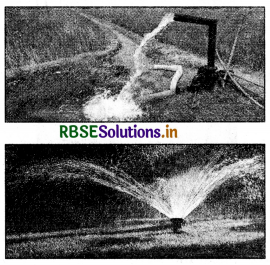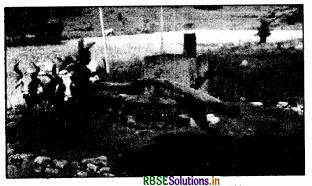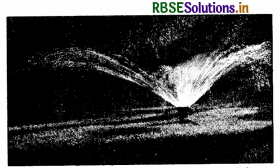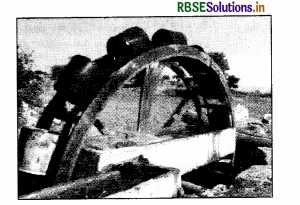RBSE Solutions for Class 5 EVS Chapter 10 Flow of Water
Rajasthan Board RBSE Solutions for Class 5 EVS Chapter 10 Flow of Water Textbook Exercise Questions and Answers.
The questions presented in the RBSE Solutions for Class 5 EVS are solved in a detailed manner. Get the accurate RBSE Solutions for Class 5 all subjects will help students to have a deeper understanding of the concepts.
RBSE Class 5 EVS Solutions Chapter 10 Flow of Water
RBSE Class 5 EVS Flow of Water Textbook Questions and Answers
Think and Answer the Following
RBSE Class 5 EVS Chapter 10 Question Answer Question 1.
Where have you seen flowing water?
Answer:
We have seen flowing water in river, canal, agricultural fields, etc.

Flow Of Water Class 5 Question 2.
At which places in your nearby area, have you seen the flowing water be¬ing used?
Answer:
We have seen the flowing water being used in agricultural fields, canal, and river, etc.
Think and Write and Answers of the Following Questions
RBSE Class 5 EVS Chapter 10 Question 1.
From where is the water available for agriculture?
Answer:
From canals, rivers, ponds, under¬ground water etc.
EVS Class 5 Chapter 10 Question Answer Question 2.
If water does not reach equally everywhere in the fields/farms, then what will be its effect on the crops?
Answer:
If water doesn’t reach equally, the crop will be badly affected. At some places, the crop will submerge due excess of water, and at some other places, the crop will get dried due to shortage of water.
Class 5 EVS Chapter 10 Question Answer Question 3.
What efforts should be make so that the entire field gets a sufficient amount of water?
Answer:
Weirs or obstructions should be made to check the flow of water. And temporary small beds should be made in the field so that water reaches in the whole field.
Explore and Write the Answers of the Following Questions

Class 5 Chapter 10 EVS Question 1.
Look at the above figures and write, how is water reaching the farms?
Answer:
Irrigation in the field is being done through a tube well with pipes and motor, and through a fountain.
Class 5th EVS Chapter 10 Question Answer Question 2.
In which methods of irrigation, the animal labour has been used?
Answer:
The animal labour is used to operate the ‘rahat’ installed over shallow wells and step wells.
Class 5 EVS Chapter 10 Question 3.
In which methods of irrigation, electricity is being used?
Answer:
Electricity is being used in using motor and pumps installed in tube wells, and in submers-ible pump.
Question 4.
In the above given figures, in what way is the property of water of How from upward to downward direction is being used?
Answer:
Tube well is installed at the highest place in the field so that the water flows from upward to downward direction and reaches in the entire field.
Question 5.
Which methods of irrigation have been used in your nearby fields?
Answer:
In our nearby fields, motor pump (en-gine), electric motor pump, canal, etc. have been used for irrigation.
Question 6.
Look at the figures given above and tell in which methods the water is being extracted from the ground.
Answer:
Through a tube well with pipes and motor, water is being extracted from the ground.
Question 7.
Which equipments have been used to extract the water from the ground?
Answer:
Pump, engine, pipe, etc.
Explore
Question 1.
For which crops, the farms are required to remain completely filled with water?
Answer:
For the crops of rice, the farms are re-quired to remain completely filled with water.
Question 2.
Which crop can be grown even with a very less amount of water?
Answer:
Crop of peas and gram can be grown even with a very less amount of water.
Learnt, Understood and Now Tell
Question 1.
The water flows from upward to downward direction. How can you use this property of water in different ways?
Answer:
When the vessels, attached to rahat, came, out from the well, they move from upward to downward direction when the wheel rotates and the water continuously falls on the parapet of the well. From here, the water flows through the drains and reaches the farms. In this way, this property of water is used.
Question 2.
In what ways we take out the wa¬ter from the well?
Answer:
The ways we can take out the water from the well simply is by using a bucket and a string, with the use of a bucket on a pulley system, using a rahat, and with the help of motor pump.
Question 3.
If the water level in the well goes down, then how can the water be taken out by rahat ?
Answer:
If the water level in the well goes down, then the water cannot be taken out by rahat.

Question 4.
Which are the different sources of irrigation ?
Answer:
The different sources of irrigation are tube well, motor pump, rahat, wells, step wells, canals etc.
RBSE Class 5 EVS Flow of Water Important Questions and Answers
Objective Type Questions
Question 1.
Choose the right option :
(i) Water from the vessels attached to rahat, falls on
(a) in pit
(b) in well.
(c) on parapet of the well
(d) in drain.
Answer:
(c) on parapet of the well
(ii) More water is required for the crop of-
(a) mustard
(b) wheat
(c) pea
(d) rice/paddy
Answer:
(d) rice/paddy
Class 5 EVS Chapter 10 Fill In The Blanks Question 2.
Fill in the blanks :
(a) Water .............. from upward to downward direction.
(b) Besides rain water, process of giving water separately (extra water) to the crops, is called ..............
(c) Underground water is found at .............. level below the ground.
(d) The requirement of .............. for every crop is different.
Answer:
(a) flows
(b) irrigation
(c) lower
(d) water.
Chapter 10 EVS Class 5 Question 3.
Match Column A with Column B :
|
Column A |
Column B |
|
Less water |
Crop of rice/paddy |
|
More water |
Crop of pea |
|
Rahat |
are deep |
|
Wells |
Wheel-like structure |
Answer:
|
Column A |
Column B |
|
Less water |
Crop of pea |
|
More water |
Crop of rice/paddy |
|
Rahat |
Wheel-like structure |
|
Wells |
are deep |
Class 5 Chapter 10 EVS Question Answer Question 4.
State True/False :
(i) Water flows from downward to upward direction.
(ii) Underground water is found at very lower level below the ground.
(iii) Through different methods, underground water is taken out for irrigation.
(iv) For operation of rahat, electricity is used.
(v) Some crops require more water, and some require less water.
Answer:
(i) False
(ii) True
(iii) True
(iv) False
(v) True.
Very Short Answer Type Questions
Class 5 Chapter 10 Question Answer Question 1.
During rainy season, where does the water flowing from fountains or rivers gets collected?
Answer:
In ponds.

Class 5 Science Chapter 10 Question Answer Question 2.
What is the effect of plenty of rain¬fall on the crops?
Answer:
If there is plenty of rainfall, then there is no scarcity of water for the crops, and there is good produce.
Class 5 EVS Chapter 10 Worksheet Question 3.
What kind of help is needed to take out the underground water?
Answer:
Equipment are needed.
Question 4.
Where is rahat installed?
Answer:
Rahat is installed over shallow wells or step wells.
Question 5.
What is used to operate a rahat?
Answer:
Oxen are used to operate a rahat.
Short/Long Answer Type Questions
Question 1.
What is the meaning of irrigation?
Answer:
When there is no rain or rainfall is scanty, then the water has to be given additionally to the crops depending upon the requirement. This process is known as irrigation.
Question 2.
How can wastage of water, in growing crops, be prevented ?
Answer:
The requirement of water for every crop is different. If a farmer has good knowledge about it, then water can be used properly. In this way wastage of water can be prevented.
Question 3.
Name two crops each which re-quire more water and less water.
Answer:
The crops which require more water
- rice
- Sugarcane. The crops which require less water-
- Peas
- Gram.
Practical
Question 1
Look at the picture given below and write dow n the steps of irrigation process.
Answer:

(i) A rahat is a wheel-like structure installed over shallow wells or step wells,
(ii) Oxen are used to operate it.
(iii) Many vessels of water are attached over it. When they enter the water inside the well, the vessles get fdled with water. When the vessels come out from the well, they move from upward to downsward direction when the wheel rotates and the water continuously falls on the parapet of the well,
(iv) From here, the water flows through the drains and reaches the farms.

Questioning
Question 1.
Look at the picture given below' in which irrigation is being done through a foun-tain. To know more about it, write down three questions.

Question 2.
Look at the picture of a rahat, and to know more about it, write down any three questions.

Answer:
- What is a rahat and where is it installed?
- What is used to operate a rahat?
- For what purpose, a rahat is used?

- RBSE Solutions for Class 5 EVS Chapter 13 Let's Play with Water
- RBSE Solutions for Class 5 EVS Chapter 11 Life in Water
- RBSE Solutions for Class 5 EVS Chapter 12 Contaminated Water Spreads Diseases
- RBSE Solutions for Class 5 EVS Chapter 3 We are Special
- RBSE Solutions for Class 5 EVS Chapter 10 जल ऊपर से नीचे की ओर
- RBSE Solutions for Class 5 EVS Chapter 6 बीज बना पौधा
- RBSE Solutions for Class 5 EVS Chapter 7 Magnificence of Trees
- RBSE Solutions for Class 5 EVS Chapter 11 जल में जीवन
- RBSE Solutions for Class 5 EVS Chapter 6 Seed Becomes Plant
- RBSE Solutions for Class 5 EVS Chapter 8 The Unique World of Insects and Animals
- RBSE Solutions for Class 5 EVS Chapter 1 Understanding Our Relations